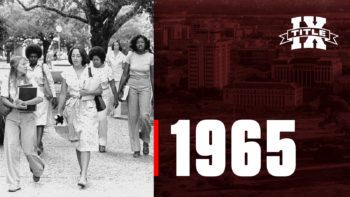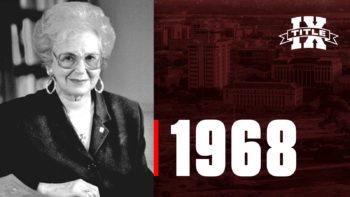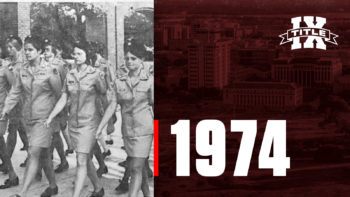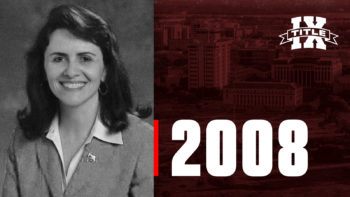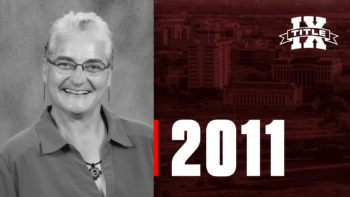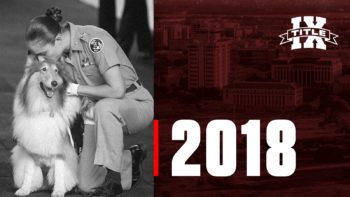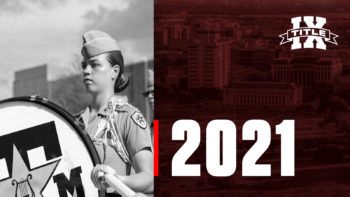Texas A&M Celebrating 50 Years Of Title IX And The Aggies Who Broke Barriers

This year marks the 50th anniversary of Title IX, a landmark piece of legislation that paved the way for all persons to pursue their educational goals by making all forms of sex discrimination illegal in federally funded educational programs and activities. Title IX of the Education Amendments of 1972 protects students, faculty, staff and visitors to the Texas A&M campus from discrimination on the basis of sex, including sexual harassment.
Texas A&M opened as an all-male military college 146 years ago. Due to Title IX and the strides made by courageous Aggies, as of fall 2021, over 47 percent of the university’s students are female, and women’s sports teams have secured national championships.
Learn about the history of Title IX and those who led the way at Texas A&M to ensure all future Aggies would have equal treatment and opportunities.
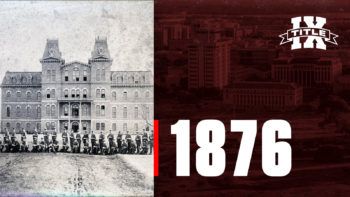
1876: Texas A&M Opens As An All-Male Military College
The Agricultural and Mechanical College of Texas, the state’s first public higher education institution, was founded as a result of the Land-Grant Act of 1862, or the Morrill Act, which provided millions of acres of federal land to states to establish colleges. Texas A&M opened its doors on Oct. 4, 1876, with an all-male student body and mandatory membership in the Corps of Cadets.
Late 1800s/Early 1900s: First Women Begin Attending Classes
In 1895, the first woman to attend classes at the A&M College of Texas was Ethel Hudson, the daughter of a Texas A&M professor – although she was not officially enrolled. During the first two decades of the 20th century, additional daughters of professors, as well as wives of students, were attending some classes, having been admitted as “special students.” Among them were Estelle Tatum and Bernice Carter, both wives of returning veterans; Emma Fountain, the daughter of a professor; and Elaine Bizzell, daughter of A&M President W.B. Bizzell.

1925: First Woman Awarded An Undergraduate Degree
On Aug. 30, Mary Evelyn Crawford was awarded a “Bachelor of Arts in Liberal Arts.”
1925: The Board Pushes Back
On Sept. 3, three days after Crawford received her diploma, the A&M College Board of Directors adopted a resolution that prohibited the admission of women students.
1934: District Judge Rules In The College Board’s Favor
1963: College Board Permits Women To Enroll On Limited Basis
Additionally that year, the Athletic Council recommended all intercollegiate sports be open to both genders.
1965: President Gen. James Earl Rudder Opens Admission To Women And African-Americans
Women were “officially” allowed to attend the university, though Rudder was required by the College Board to approve each applicant.
1967: First Woman Earns An A&M Master’s Degree
Sallie Sheppard became the first female graduate student to earn a master’s degree. One of the first women formally admitted, Sheppard earned bachelor’s and master’s degrees in mathematics in 1965 and 1967, respectively. She taught at A&M for 20 years in the Department of Computer Science, and in 1987 became the university’s first female associate provost.
1967: First Woman Earns A Doctorate
International student Shanti Kudchadker, who studied chemistry, became the first woman to graduate with a Ph.D. from Texas A&M.
1968: Texas A&M Names Its First Woman Professor
Betty Miller Unterberger, who taught history, became the first female full professor with tenure. She was perhaps best known for her work with honors students. In 2004, Texas A&M presented her the Betty M. Unterberger Award for Outstanding Service to Honors Education, which continues to be awarded to faculty, solidifying her legacy after her passing in 2012.
1969: Unrestricted Admission Of Female Students Begins
1972: President Richard Nixon Signs Title IX Education Amendments Act
Title IX is widely considered to be a groundbreaking gender equality law. It states: “No person in the United States shall, on the basis of sex, be excluded from participation in, be denied the benefits of, or be subjected to discrimination under any education program or activity receiving Federal financial assistance.” This included athletics as prior to Title IX, opportunities for female athletes were extremely limited. This same year at A&M, campus housing opened to female students for the first time.
1974: Women Admitted To The Corps Of Cadets
Following a federal court ruling, female Aggies were free to join the Corps.
1975: Women’s Drill Team Created And First A&M Chapter Of A Sorority Established
1976: First Woman Earns A Full Athletic Scholarship
Track-and-field athlete Linda Cornelius Waltman became the first female Aggie to earn a full athletic scholarship. She was a member of the 1980 Olympic Team and in 1985 became the first woman inducted into the A&M Sports Hall of Fame.
1977: Roxie Pranglin Becomes First Female To Lead A Corps Unit After Serving All Four Years
1978: Sara Alpern Teaches A&M’s First Women’s History Course
Professor of History Sara Alpern, along with three other female members of the faculty in the College of Liberal Arts, founded A&M’s Women’s and Gender Studies program to examine the lives, challenges and contributions of women. The first course to be offered was Women’s History, taught by Alpern, and course offerings expanded during the 1980s. Alpern also turned the informal Women’s Faculty Network into a recognized organization during her time as its president in 1991-92.
1978: Female Cadets Allowed To Participate In Bonfire Cut For The First Time
1979: Female Cadet Moves To Open More Activities To Women
Cadet Melanie Zentgraf, a senior, filed a class-action lawsuit asking A&M to allow women in the Aggie Band, Ross Volunteers, Fish Drill Team and Color Guard. In 1985, a judge approved the settlement and the Corps was forbidden from blocking the membership of women in its organizations.
1980: Uniform For Female Senior Cadets Includes Boots For The First Time
1981: Leaugeay C. “Beebe” Barnes Becomes First Woman To Join Parsons Mounted Cavalry
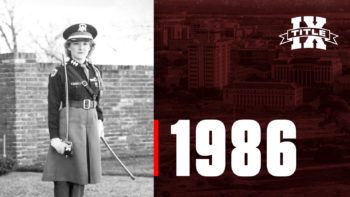
1986: Corps Continues To Open To Female Cadets
Mandy Schubert, the first female cadet on Corps Staff, became the highest-ranking female cadet as deputy commander. Schubert and Nancy Hedgecock become the first women to serve as Ross Volunteers.
1990: First Corps Units Become Gender-Integrated; Women-Only Units Eliminated
1990: First Female Dean
Jane Stallings is named dean of education, becoming the first woman to serve as the dean of a college at A&M. Stallings, who died in 2016, helped establish numerous programs in the college, including the Dean’s Roundtable, which honors educators who are role models to their students and peers, as well as the Learning to Teach in Inner City Schools teacher program. The college continues to honor Stallings with the Jane Stallings Student Service Award, which recognizes outstanding senior education undergraduate students who demonstrate exceptional service and commitment to the teaching profession.
1992: Corps Stands Against Harassment And Discrimination
After female cadets reported they were experiencing harassment and discrimination following gender integration, the Corps issued a written statement condemning such behavior.
1994: Two Of The Highest Offices
This year saw two prestigious offices filled by women when Mary Nan West became the first woman president of the Board of Regents, and Brooke Leslie, an agricultural development major from Fort Worth, was elected student body president.
1994: Women’s Programs In Department Of Student Life Opens, Later Renamed Gender Issues Education Services (GIES)
1998: Janis Stout Becomes First Woman To Serve As Dean Of Faculties And Associate Provost
2001: A&M’s Women’s Resource Center Opens
After merging and then unmerging with GIES, the Women’s Resource Center today is focused on “improving gender relations on campus, raising awareness and encouraging open discussions of gender issues, supporting the personal and academic growth of women on campus, and offering programming and support on the topics of sexual harassment, women of color, violence against women, and lesbian/bisexual women.” GIES eventually became the GLBT Resource Center, today the LGBTQ+ PRIDE Center.
2008: First Woman President Of Texas A&M
Elsa Murano began at Texas A&M in 1995 as a professor of food science and food technology, then as dean and vice chancellor of the College of Agriculture and Life Sciences (2005-2007). She became the first female and first Hispanic president of the university in 2008, serving for 18 months. Murano is currently the director of A&M’s Norman Borlaug Institute for International Agriculture.
2011: First Woman Provost And Executive Vice President
A Regents Professor in the Department of Electrical and Computer Engineering, Karan Watson became the first woman to assume the helm over academics at Texas A&M.
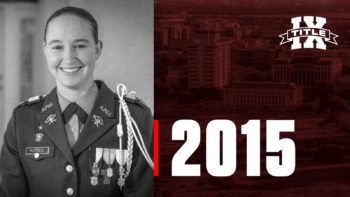
2015: First Female Corps Commander
After 139 years, the Corps of Cadets selected a woman to lead as corps commander. Alyssa Michalke ’16 of Schulenburg, Texas, was a junior at the time she was selected, with a dual major in ocean and civil engineering.

2016: All Female Top Student Leadership
For the first time in A&M’s history, women swept the top student leadership posts with Student Body President Hannah Wimberly ’17, Corps of Cadets Commander Cecille Sorio ’17 and Class of 2017 President Claire Wimberly all holding office during the 2016-17 school year.
2018: First Woman Serves As Reveille’s Handler
Mia Miller ’21 made history when she became the first woman to secure the enviable position as handler for A&M’s beloved mascot, Reveille. The nursing student from Hewitt, Texas, was announced as Reveille IX’s handler for the 2018-19 academic year.
2021: First Female Bass Drummer
Amanda Lovitt ’23 became the first female bass drummer for the Fightin’ Texas Aggie Band. She said at the time she hoped her success inspires other young women to achieve their goals.
For more on the history of inclusion at Texas A&M, read the Office for Diversity’s inclusion timeline.
Media contact: Lesley Henton, lshenton@tamu.edu
